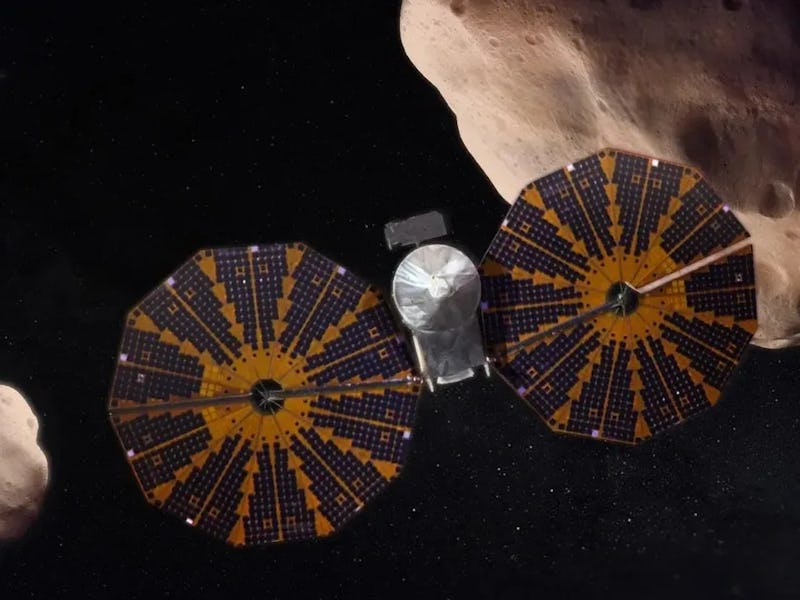NASA’s Lucy Spacecraft Is About To Flyby An Asteroid In Its First Major Test Flight
On November 1, the spacecraft will arrive at the small asteroid Dinkinesh.

On November 1, NASA’s Lucy spacecraft will visit its first asteroid, Dinkinesh. Their meeting will be a critical, ultra-brief encounter between two of the loneliest drifters in the Solar System.
Lucy has already been flying through space for two years. The mission, designed to take a grand tour of the Trojan asteroids near Jupiter, will perform ultra-fast flybys to accomplish its epic survey of nine rocks strewn across space. Although it's a 12-year mission, Lucy's principal investigator Hal Levison tells Inverse that all the important science it will take adds up to just 24 hours.
Lucy won’t sit in orbit around a grand planet or fixate on numerous celestial objects like other spacecraft. Most of Lucy’s existence will be spent weaving through the Solar System, slicing through space at six to nine kilometers per second to check off its itinerary of two rocks in the main asteroid belt, a set of Trojans ahead of Jupiter in its orbit, then zipping across the inner Solar System past Earth to meet the Trojans behind Jupiter.
Asteroid Dinkinesh will be the smallest asteroid in the main asteroid belt to ever be visited by a spacecraft, Levison says. It’s so small that few missions could justify the resources to visit such a puny rock. Its diminutive nature even inspired Levison to nickname it “Dinky.”
It wasn’t part of the Lucy mission until just last year, well after Lucy was in space.
“When we originally planned the mission, we didn’t really consider things as small as Dinkinesh. We thought they would be too hard to do and wouldn’t be as productive as going to the larger objects,” Lucy project scientist Keith Noll tells Inverse. But the serendipitous discovery that this asteroid happens to fly just 60,000 kilometers near Lucy’s path meant that it would require very little fuel for the spacecraft to visit it up close.
Don’t blink, or you might miss it
The visit to Dinkinesh offers the first major testing opportunity in space for Lucy.
“We want to do as many tests as we can,” Levison says. For instance, the stakes are high for asteroid Eurybates, the first Trojan on Lucy’s list and one of the mission’s highest-priority targets. Like all of Lucy’s targets, the spacecraft only gets one shot to see each asteroid. “We can’t blink because if we blink, we’ll miss it,” Levison says.
An illustration of the Trojan asteroids ahead of and behind Jupiter.
Before Dinkinesh entered the roster, the mission team planned to test out Lucy’s capabilities on a main belt asteroid called Donaldjohanson. Dinkinesh allows the team a second round of testing, effectively splitting up the evaluation and getting some of it done a year and a half earlier than planned. Lucy won’t visit Donaldjohanson until April 20, 2025.
If Lucy doesn’t work as it should, say because the solar panel that didn’t fully deploy shortly after launch creates a problematic dynamic in space, they’ll have more time to make software changes. “If you’re going to fail, fail faster,” Levison says.
Dinkinesh gained a visit for the purpose of software testing, but it’s also interesting in its own way. Levison says the half-mile-wide asteroid has a size more comparable to those near Earth, while main belt asteroids tend to be larger. Data on “dinky” Dinkinesh in the main asteroid belt “is going to fill the gap” between both populations, Levison says.
Lucy’s flyby of Dinkinesh
On November 1, lonesome Lucy and desolate Dinkinesh will meet. Lucy will fly past Dinkinesh in almost exactly the same way as it will encounter the Trojans, with the Sun illuminating one side of the rock and making it look almost like a half Moon, Noll says. It’s a great opportunity to test the terminal tracking cameras that use a software system to autonomously identify when the blob in the sky is becoming bigger and brighter as it gradually reveals itself as the asteroid of interest.
On that day, the team will see if Lucy keeps the cameras pointed at its target. This finesse will help the Lucy mission team answer major questions about the Trojans, how they go to where they are, and what Solar System secrets they may reveal.
Editor’s Note: An earlier version of this story referred to Dinkinesh as the smallest asteroid ever visited by a spacecraft. It is actually the smallest asteroid in the Main Asteroid Belt to be visited. Other, smaller near-Earth asteroids have already been visited by spacecraft.